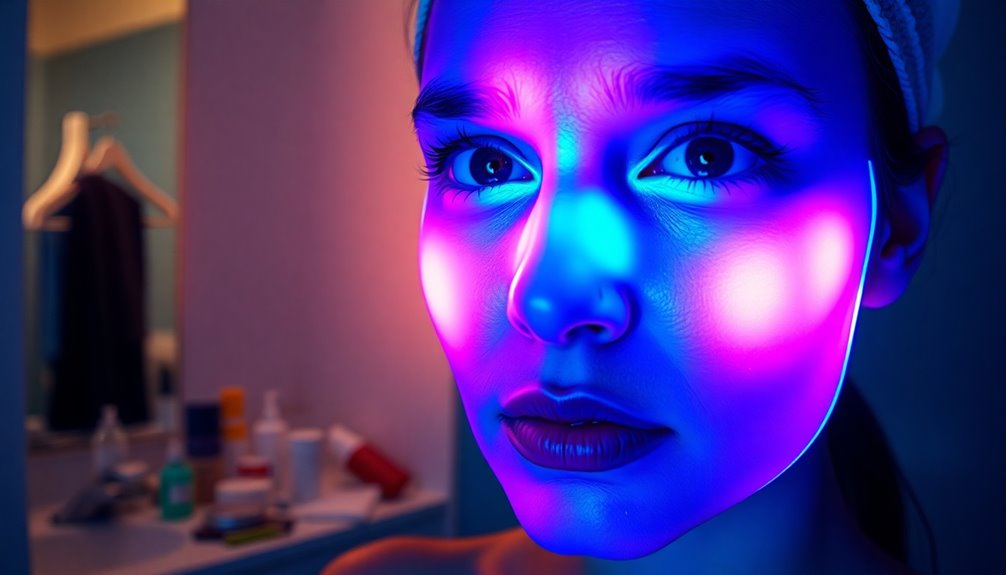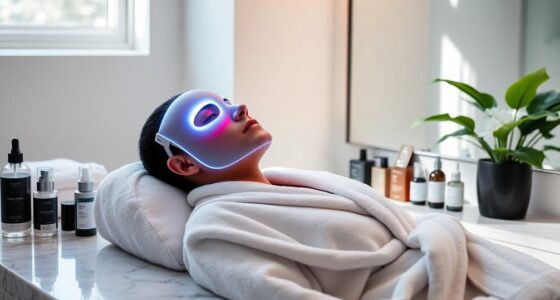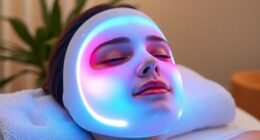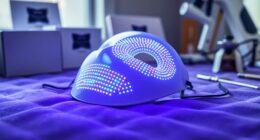While LED face masks promise skin benefits, there are significant disadvantages to consider. Their at-home versions often provide shallow light penetration, leading to mild results that require ongoing use. Prolonged use can cause skin irritation or redness, especially for those with pre-existing conditions. Additionally, many masks lack proper safety testing, raising concerns about their effectiveness and safety. Eye protection is crucial due to the risks of blue light exposure. Understanding these factors can guide your next skincare choice.
Key Takeaways
- At-home LED masks offer limited light penetration, resulting in minimal effects compared to medical-grade devices.
- Prolonged use may cause skin irritation, especially for those with existing skin conditions.
- Eye safety is a concern, as certain wavelengths can harm vision; protective eyewear is essential.
- Many LED masks lack thorough safety testing and transparency, increasing the risk of ineffective purchases.
- Continuous use is often required for benefits, necessitating realistic expectations and careful product evaluation.

While many people turn to LED face masks for a convenient skincare boost at home, it’s essential to understand their limitations. Although these devices are marketed as effective tools for treating various skin concerns, their effectiveness mightn’t meet your expectations. Unlike medical-grade devices that deliver stronger light intensity and penetrate deeper into the skin, at-home LED face masks often provide only shallow light penetration. This means that for many users, the results may be mild and require continuous use to see any noticeable improvements. If you’re investing your time and money into these products, it’s crucial to be aware of what you might actually achieve. Additionally, many users may find that their skin responds differently to LED therapy, with varying outcomes depending on individual skin types and concerns. For those specifically seeking the best led masks for glowing skin, it’s important to research and select devices designed for your particular needs. Remember, while these masks can complement your skincare routine, they shouldn’t be seen as a substitute for professional treatments or a robust skincare regimen.
You should also consider the potential for skin irritation. Prolonged use of LED masks can lead to increased sensitivity, redness, or other forms of irritation, especially if you have pre-existing skin conditions or light sensitivity. It’s important to listen to your skin; if you notice any negative reactions, it might be wise to discontinue use or consult a dermatologist. The last thing you want is to exacerbate existing skin concerns or create new ones because of a poorly suited product.
Another critical issue is eye safety. Many LED masks utilize blue light, which can be harmful without proper protective eyewear. Exposure to certain wavelengths may lead to vision changes or even damage over time. If you decide to use an LED face mask, consider wearing goggles or taking precautions to protect your eyes. You might think of this as an extra step, but your vision is worth safeguarding.
Moreover, many at-home LED face masks lack comprehensive safety testing and transparency regarding their effectiveness. This lack of accountability could lead to financial waste on products that ultimately don’t deliver the promised results. Before making a purchase, research the brand and look for reviews from other users. Investing in a product without proper safety testing mightn’t be the best decision for your skincare routine.
Frequently Asked Questions
What Are the Disadvantages of LED Face Masks?
When considering LED face masks, you might find several disadvantages. They often provide less effective light penetration than professional treatments, which can limit their benefits.
Many consumer models lack enough scientific backing, creating uncertainty about their safety and effectiveness. Prolonged use may irritate sensitive skin, and blue light can contribute to photo-aging.
Additionally, the initial investment mightn’t yield noticeable results, especially when more impactful in-office treatments are available.
What Are the Negatives of LED Light Therapy?
When considering the negatives of LED light therapy, you might find that it can sometimes lead to skin irritation or sensitivity, especially if you have pre-existing conditions.
Prolonged exposure to certain wavelengths, like blue light, may even cause skin damage over time.
Additionally, the lack of robust scientific evidence for at-home devices could leave you questioning their effectiveness.
Don’t forget to prioritize eye safety, as improper use can lead to vision issues.
What Does the Mayo Clinic Say About Red Light Therapy?
The Mayo Clinic notes that red light therapy, including LED face masks, shows promise for improving skin texture and reducing wrinkles, but they emphasize the need for more research.
They mention that while some users see subtle improvements, at-home devices mightn’t be as effective as professional treatments.
It’s also crucial to consult a dermatologist before starting, especially if you have sensitive skin, and to use proper eye protection during sessions.
Who Shouldn’t Use a LED Mask?
If you have light sensitivity or take medications that heighten this sensitivity, you should avoid LED masks.
Those with active skin conditions like eczema or rosacea may face irritation, so consulting a dermatologist is wise.
If you’ve got a history of eye problems related to light, it’s best to skip LED masks without proper protection.
Pregnant or nursing? It’s safer to avoid these treatments until more safety data is available.
Conclusion
While LED face masks can offer benefits, it’s crucial to recognize their disadvantages. Skin irritation, sensitivity to light, and potential eye damage are real concerns that shouldn’t be overlooked. Plus, they might not deliver results for everyone, leading to disappointment. Always consult with a dermatologist before trying new treatments, and consider your skin type and any underlying conditions. By being aware of these drawbacks, you can make a more informed decision about whether LED masks are right for you.









